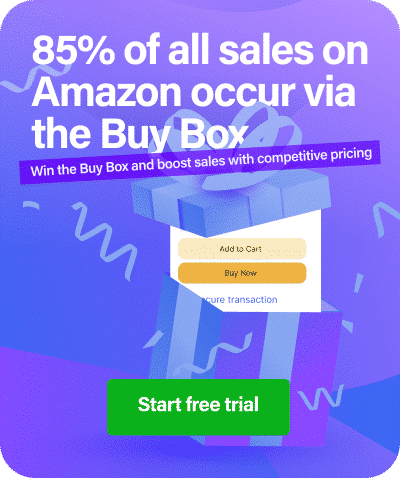Just those three little characters – SEO – are enough to strike fear into even the most technically minded of online sellers. Most often associated with Google, SEO is often perceived as the stuff of nightmares for those unfamiliar with the process of search engine optimization. But SEO isn’t all about Google.
If you sell on Amazon, SEO on the platform is critical for your products to rank highly in the search results for the keywords relevant to your products. In simple terms, by optimizing your Amazon product listing, you make it much easier for Amazon and its unique algorithm (more on that in a moment) to uncover your listing and choose to show it to potential buyers.
It’s the goal of every Amazon seller to have their product achieve a top position on the first search engine results page (SERPS), and that’s precisely why an understanding of Amazon SEO is needed. If you fail to grasp and implement Amazon SEO, you will receive less traffic and minimal sales.
In a nutshell: Amazon SEO = Optimization = High Rankings = High Visibility = More Sales = More Profit = Successful Amazon Seller!
Simple. Well, you’d think so, but unlike Google, which has an algorithm in its own right, Amazon SEO works differently. There are several factors and ranking signals that you must consider if you are going to get your Amazon listings working efficiently for you.
Importantly, throughout the whole Amazon SEO process, you should remember that Amazon is primarily a buying platform with almost every search being transactional and so should be treated as such when you are considering your Amazon SEO strategy.
How Does Amazon SEO Work?
When a buyer on Amazon searches for a product, they will usually enter a keyword or keyphrase into the search box and wait for results to be returned. The results returned are a direct result of Amazon SEO.
Once the results pop up, buyers are most likely to click on the options that appear on the first page and will rarely continue to page 2, 3 or 4. This is simply what most buyers do! It’s a natural choice to browse the first page because that’s where buyers expect to see the best and most relevant results relating to their original search.
As an Amazon seller, you obviously want to appear on that first page because you’ll be more visible, and you’ll sell more. In fact, the higher you rank, the more sales you will make. Languish on page 2 or 3, and your chances of a sale diminish.
So, to make sure your product listing appears on page 1 of the Amazon search results, you must understand that the most important things to get right involve performance and relevance.
Factors which influence your Amazon search ranking are:
- Amazon Product Listing Optimization
- Amazon Keyword Optimization
- Amazon Product Title Optimization
- Amazon Product Image Optimization
- Amazon Backend Keywords
- Amazon Pricing Strategy
- Amazon A9 Algorithm
Each of these is as important as the next and should be understood and implemented on every Amazon product listing you launch.
What is the Amazon A9 Algorithm?
Developed by Amazon, A9 sounds like a mysterious title; indeed, many have never heard of it, but it is only called this because it’s the name of the company that handles Amazon SEO – so no real intrigue there!
While the Amazon A9 algorithm is similar to Google’s search algorithm, it is not as precise. Yes, it analyses keywords and matches buyer searches with the relevant products. Still, unlike Google, Amazon is only concerned with getting people to buy stuff – because that’s what Amazon visitors are on the site for.
Amazon’s A9 algorithm is concerned with search and performance-related aspects. It has one job only: To analyze data and answer customer search queries with relevant products that are most likely to sell.
Your job as a seller on Amazon is to make sure you provide the data Amazon A9 is looking for.
To do this, you need to go back to the list of factors that influence Amazon SEO and then implement them.
Let’s go through those now.
Amazon Product Listing Optimization
Your overall product listing needs to include a combination of all the other influencing factors to benefit your Amazon SEO.
- A keyword-relevant product title
- Bullet points including features and benefits
- An accurate main description
- Product images
Your product listing must include every last detail that a customer would want to know to make an informed decision and purchase your product.
Amazon Keyword Optimization
Keywords are the first significant factor for the Amazon A9 algorithm so are super important. If your product listing doesn’t include the keywords being searched for by Amazon customers, your listings won’t appear.
Put yourself in the shoes of your ideal buyer and imagine the keywords they would use to search for your product. This is by far the best starting point when it comes to your keywords, and these are highly likely to be those that Amazon customers will use in the search bar.
Amazon Autocomplete
This is a handy free search method which allows you to see suggested search terms that Amazon customers use frequently. This is a hugely valuable source of relevant keywords. Simply start typing a keyword in the search box to see suggestions of previous searches and then follow it with A, B, C and so on to see more search results combinations.
View Your Competitors Keywords
Your competitors are likely to be using relevant keywords for your product. Enter a primary keyword and then look at the top results for other product listings similar to yours. This is another easy and free way of finding keywords.
Keywords Everywhere
For more exact keywords, you will be required to do some research using a paid-for tool such as Keywords Everywhere. This is an add on for your Chrome or Firefox browser that provides the search volume and other data of any keyword you search for. What’s most exciting is that it works on any website, including Amazon.
Once you have a list of relevant keywords, you have a basis to start adding these within all the other aspects of your product listing and can really start ramping up your Amazon SEO.
Remember: Always include all relevant keywords in your Amazon product listing.
How to Optimize Product Titles for Amazon SEO
Your Amazon product title must be super relevant, packed with juicy keywords, because Amazon’s A9 algorithm will analyze your title and decide its relevance to a customer’s search based on the keywords you have used.
So, if a customer searches for a ‘black shoulder bag’ and you are selling one, you must have all three of these primary keywords in your product title so that your listing appears in the search results.
Alongside those most relevant keywords, you should add all other relevant keywords.
Take your time when planning your Amazon product title as it’s one of the most critical aspects of Amazon SEO. You may have to test and tweak before you get it right.
Important Points:
- It does not matter in which order you place the keywords in your title.
- Your brand should be included, but it does not help with optimization.
- Make sure your title is not too long or too short.
- The ideal Amazon product title length is less than 200 characters.
- For mobile optimization, stick with approximately 80 characters.
- Avoid keyword stuffing – it will work against you!
How to Optimize Bullet Points for Amazon SEO
The Amazon A9 algorithm will also analyze the bullet points within your Amazon product listing. These are relied on pretty heavily by shoppers because they are scannable. This makes them quick and easy to read. They are also the part of your listing that will actually sell your product so don’t overlook them for Amazon SEO.
Your bullet points should be highly descriptive and include the five key features and benefits of your product. For example, crucial information such as size, colour, ingredients and so on.
When you write your bullet points, integrate your primary and secondary keywords in the most natural way you can so that each point flows and is also optimized.
Critically, pay attention to the length of each bullet point as not only does this make them more readable, but the Amazon A9 algorithm will only see the first 1000 characters. With this in mind, to avoid wasting keywords that may not be seen, keep each bullet point to a maximum length of 200 characters for ultimate optimization.
Important Points:
- Choose five key features and benefits.
- Weave primary and secondary keywords into your points naturally.
- Stay below 1000 characters overall or 200 characters per bullet point.
- Use descriptive words and phrases.
How to Optimize the Main Description for Amazon SEO
Unfortunately, your Amazon main description is part of your listing that is likely to get overlooked! It’s tiny, it’s not easy to find and languishes at the very bottom of your product page. It’s rare for a customer to scroll to the main description on Amazon, hence why your bullet points are so crucial.
That said, you should add the main description because it all helps with your Amazon SEO. Just a few paragraphs will suffice to describe the main product features and benefits, along with more specific technical information if applicable. Here you can add warranty information, care instructions and any other product information useful to customers.
Now here’s the key. For your main description to be an influencing factor in Amazon SEO (and to help your listing appear in the search results) two or more searched for keywords must appear in the description, and at least two other searched for keywords in the bullet points or backend keywords (more on these shortly).
So, it’s worth ensuring your keywords remain consistent through all parts of your product listing.
And don’t forget, your product description keywords can also be relevant for Google searches!
Important Points:
- You must have two searched for keywords in your main description.
- You must have two searched for keywords in your bullet points or backend.
- Write short paragraphs.
- Include features and benefits.
How to Optimize Backend Keywords for Amazon SEO
Backend keywords are often overlooked by Amazon sellers who don’t understand the importance of SEO. These keywords are not visible on your main product listing and can be added in Seller Central. The exciting part is that they can directly influence the discoverability of your product – that’s how vital they are.
Backend keywords should be carefully thought out with the best practice being to include alternative spellings of keywords, related search terms and longtail keyphrases.
The most important thing to remember with backend keywords is that your phrases must make sense to make a difference to your visibility. So, for example, you would add ‘red dog lead’, rather than ‘dog lead red’.
The character limit for your backend keywords is 250, including punctuation and spaces so use those characters wisely.
Important Points:
- Do not repeat keywords already used in your product title.
- Add alternative spellings.
- Don’t use singular and plurals – one or the other is enough.
- Add longtail keywords as sentences.
How to Optimize Product Images for Amazon SEO
While your Amazon images don’t directly affect your Amazon search ranking, they are important for Amazon SEO purposes because listings which feature high-quality images have higher conversion rates. Products with high conversion rates are deemed popular and so are more likely to be shown in the search results and thus achieve higher rankings.
Your product images should be sharp, pleasing to look at and accurately represent your product.
Important Points:
- Use a white background.
- Follow Amazon’s image guidelines: Images should be at least 1,000 pixels wide by 1,000 pixels tall to enable zoom.
- Images should be square and accurately represent the product.
How to Optimize Your Pricing Strategy for SEO
Keeping an eye on your competition should be second nature to you as you mustn’t price yourself out of the market.
What you may not realize is that how you price your product can affect your Amazon SEO. The bottom line is that if you charge too much compared to your competitors, you won’t be seen as competitively priced in the market, and this will directly affect your conversion rate.
Unfortunately, if you sell fewer products compared to your competitors, Amazon A9 will assume that your product is not as worthy, and your ranking will suffer, so all that search engine optimization you’ve done will potentially be useless.
Important Points:
- Keep an eye on your competition.
- Price your products competitively.
Final Thoughts
As you have discovered, there’s much to consider when implementing a successful Amazon SEO strategy. Amazon’s A9 algorithm can also change at any time. What is known though is that your keywords play a huge role with the Amazon A9 algorithm and so this is an area that you should be most concerned with when optimizing your Amazon listings.
Repricer.com is the fastest Amazon repricer on the market and a proud member of Amazon’s Marketplace Developer Council. Try repricing free for 14 days and increase your profits on Amazon, eBay, Walmart, Shopify and more.





